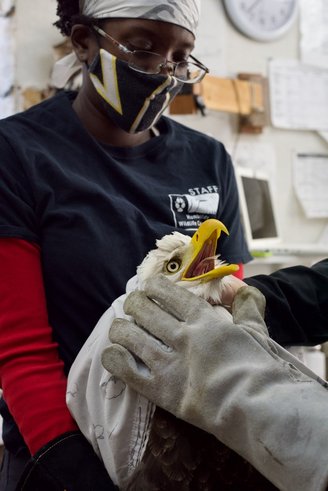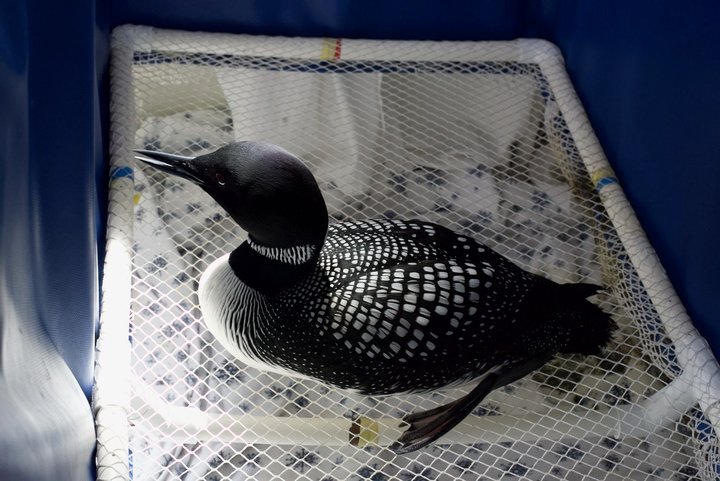Common Loon, currently in care, found at Prairie Creek. Photos: Laura Corsiglia/BirdAllyX
Life here in the redwoods is an experience like none other. This ancient rainforest we call home is host to an abundant variety of wildlife which also call this place home. And while our close proximity to nature and all of its glory can be a blessing, more and more animals show up on the doorsteps the Humboldt Wildlife Care Center. The Care Center, located in Bayside, operates as a wildlife rehabilitation center for injured and sick animals that are on the brink of dying, providing a lifeline for them whenever possible. The main culprit for them showing up there? Us.
I sat down with the Care Center’s Monte Merrick to gain some insight into what we as a community can do to prevent more patients from being admitted, as well as practical measures we can employ at home to minimize conflict between us and our furry and feathered neighbors.
The most common species that end up at the Care Center are raccoons, mallards (ducks), opossums, and, as Monte put it, “…a large diverse group we’ll just refer to as songbirds.” So, why are all of these animals showing up here? Well, the short answer is us, but it’s a little more complex than that.
“The most frustrating part of this job are patients that we just don’t know why they’re here,” says Monte. “The person finds them, knows nothing about them, and we guess based off where they are and what’s around them what happened to them.” For the patients that we do know what happened to them, roadside collisions are definitely the most common reason for admittance. However, for songbirds, outdoor cats take the cake on that.
Every outdoor cat owner I’ve ever met has had countless stories of their pet bringing birds and small mammals into their homes either dead or alive, and while your cat means no harm by this, it’s still annoying when you’re trying to watch TV and now you have to chase a rat around your house for 45 minutes and shoo it out the front door with a broomstick. A paper published in 2013 estimated that free-ranging (outdoor) domestic cats kill between 1.3 to 4 billion birds annually, and between 6.3 to 22.3 billion small mammals (Loss et al. 2012). Outdoor cats have a bit of a reputation worldwide for being cute little extinction machines, having been the main reason for 63 species extinction events worldwide, and 26 percent percent of all bird, mammal, and reptile extinctions.
The most effective tool to combat this? Keeping your cat inside.
Now, the main reason most people let their cats outside is because they love them, and argue that keeping them inside their whole life is cruel. “My biggest reason for keeping my cats indoors, is because I love my cats”, explains Monte. “I lost my first cat when I was 7 years old to a car [hitting her], ya know? She came crawling up on the back porch with her back half all squashed flat… and then there’s cats fighting ,which spreads feline leukemia, which I lost one to back in my days of outdoor cats. And then there’s other predators like coyotes and bobcats, which prey on them too.”
According to the Humane Society, the average lifespan of an outdoor cat is between 2-5 years, while the average lifespan of an indoor cat is around 10-15 years. It really comes down to your cat’s well-being, and having them outdoors without your supervision is not only a threat to themselves but local wildlife as well. I asked Monte if protective measures like bibs and bells on the cat’s collars have any effects on preventing them from capturing birds and mammals, and he tell me “There may be some diminishment of it…but broadly speaking, no. Plus, they do nothing for coyotes and cars, that’s for sure.”
If these reasons are still not convincing enough to keep your cat inside, there are still safe ways to get your feline friend some vitamin D. Usually reserved for dogs, cats actually do very well on a leash in some cases, and it keeps them safe and out of trouble. If your cat isn’t into the whole leash thing, there’s still a solution for them too! Catios, or patios for your cat, have been a hot new trend for those wishing to grant their pet access outside without the threat of them killing animals or themselves. While time-consuming and a bit more expensive than a leash, this method is a great way to get your cat the enrichment they need without worrying about them bringing back a new “present.”
Spring is here! Which means bird nests will soon be popping up seemingly out of nowhere on your front porch or under the eaves of your house, leaving a fresh pile of bird poop in its wake. It’s important to note that active nests are protected under the Migratory Bird Treaty Act, and while it’s morally wrong to destroy an active bird’s nest, it’s also an international crime. What isn’t a crime though, is catching it before it gets occupied.
“If you have birds that you think are beginning to build a nest, this is the time to prevent them from doing that,” Monte tells me. “So, things like swallows building a mud nest under your eaves; if you don’t want it there, you need to discourage them from that now, but to do so, you have to do it in a way that doesn’t threaten their life. Putting screening up under your eaves works very well.” The screening, like the ones used on your windows, is strong enough, cheap enough, and has holes small enough to keep them at bay.
Skunks and raccoons love denning underneath homes, and from their perspective it makes sense. “They’re just looking for a safe [dry] place for their babies when they have to go out and do things [find food]. For raccoons, it’s very common that they set up a den site behind your bathtub, and you don’t even know how they got there because they can squeeze into small openings and crawlspaces, it’s a really good spot for them. First of all, who’s gonna follow them in there? No one. And heck, it [the bathtub] even gets warm once in a while!”, says Monte. He goes on to tell me, “People call us and say, ’we think we hear something under the house, and there’s some noise coming from under the bathtub.’ It’s like, I KNOW it’s going to be a raccoon. It’s actually one of the reasons I have such admiration for them; their ability to MacGyver their world using our stuff.”
While people like Monte and I love raccoons, that love can quickly turn into hate when they begin damaging your property, and nobody likes that. I asked him what methods he would employ to discourage raccoons from setting up shop in or under your house. Of course, not everyone lives in a home with foundations and pre-built defenses to keep animals from burrowing under or in your house, so things like trailers and apartment complexes are a bit tricky. He tells me, “You can do things like hardware cloth that attaches to the side of your house, then dig down and in about 18 inches down and about a foot out so that they won’t dig under it and get under your house…There is some expense and some labor involved but it is effective.”

Bald Eagle brought to the care center in December 2021 with signs of electrocution from transmission lines. Rescuers tried to save the bird by sending to another facility, but the wounds were too severe and euthanasia was the outcome.
Deer grazing on your landscaping can be frustrating, and your hard work on keeping your garden looking nice can quickly be gone within a couple days if your defenses aren’t there. I asked how someone can keep deer from tearing through their garden, Monte says “There is fencing, which is the number one thing to do, but you have to be really careful of because it also becomes a terrible entanglement for birds, and not just songbirds but raptors as well. I’ve pulled a lot of raptors out of deer fencing from them chasing after songbirds into shrubs. But good fencing that is visible and far enough away from the plants really is the most effective way.”
Discovering an injured bird can be daunting, and knowing what to do in that moment upon discovery can mean life or death for them. I ask Monte about what someone should do upon finding an injured bird. He tells me: “For songbirds, the first thing you should do is attempt to capture them and get them into a safe place like a shoebox. For raptors and other birds that can hurt you is another story. If you’re not confident in your ability to safely capture them, give us a call and we can guide you in safe ways using gear around your house to pick them up, or we can send someone out there to do it for you. Ultimately, picking them up [safely] and bringing them to us is the best thing to do.”
It’s also important to note that depending on the time of the year, some fledgling [baby] songbirds don’t need help if you find them on the ground. It’s common for birds like sparrows to spend some time on the ground as they’re learning how to fly, so calling the Care Center and telling them the situation can save you the time and worry for their wellbeing. “If you’re not certain, the best thing to do is call us,” says Monte.
Raccoons and rats are a common problem for homeowners that keep having them dig into their trash and compost. While it seems like a lot of work, predator-proofing your trashcans and compost bins can actually be done quite easily.
“We [at the Care Center] use hardware cloth on our compost, which is just wire mesh with a half inch spacing,” Monte says. “We use this because it’s basically the best way to keep rats out, and has the added benefit of also keeping larger species like raccoons out as well.”
Lining the base and sides with hardware cloth on your compost makes it almost 100 percent effective against all animals. For garbage bins, placing something heavy on top can keep raccoons from accessing your garbage. But if all else fails, fitting a latch on the lip of the bin and clipping a padlock to it will always work for keeping out any unwanted trash pandas.
If you or someone you know would like to volunteer or donate to the Humboldt Wildlife Care Center to help these dedicated wildlife rehabilitators and what they do for our community, you can go to www.BirdAllyX.net, email info@birallyx.net or call (707)822-8839 for any information.
I’d like to thank Monte Merrick for participating in this interview and all the staff and volunteers at the Humboldt Wildlife Care Center for what they do for all the animals in and around Humboldt, Del Norte, Trinity and northern Mendocino counties.
###
Hunter Perez is a senior studying wildlife management and conservation at Cal Poly Humboldt.

CLICK TO MANAGE